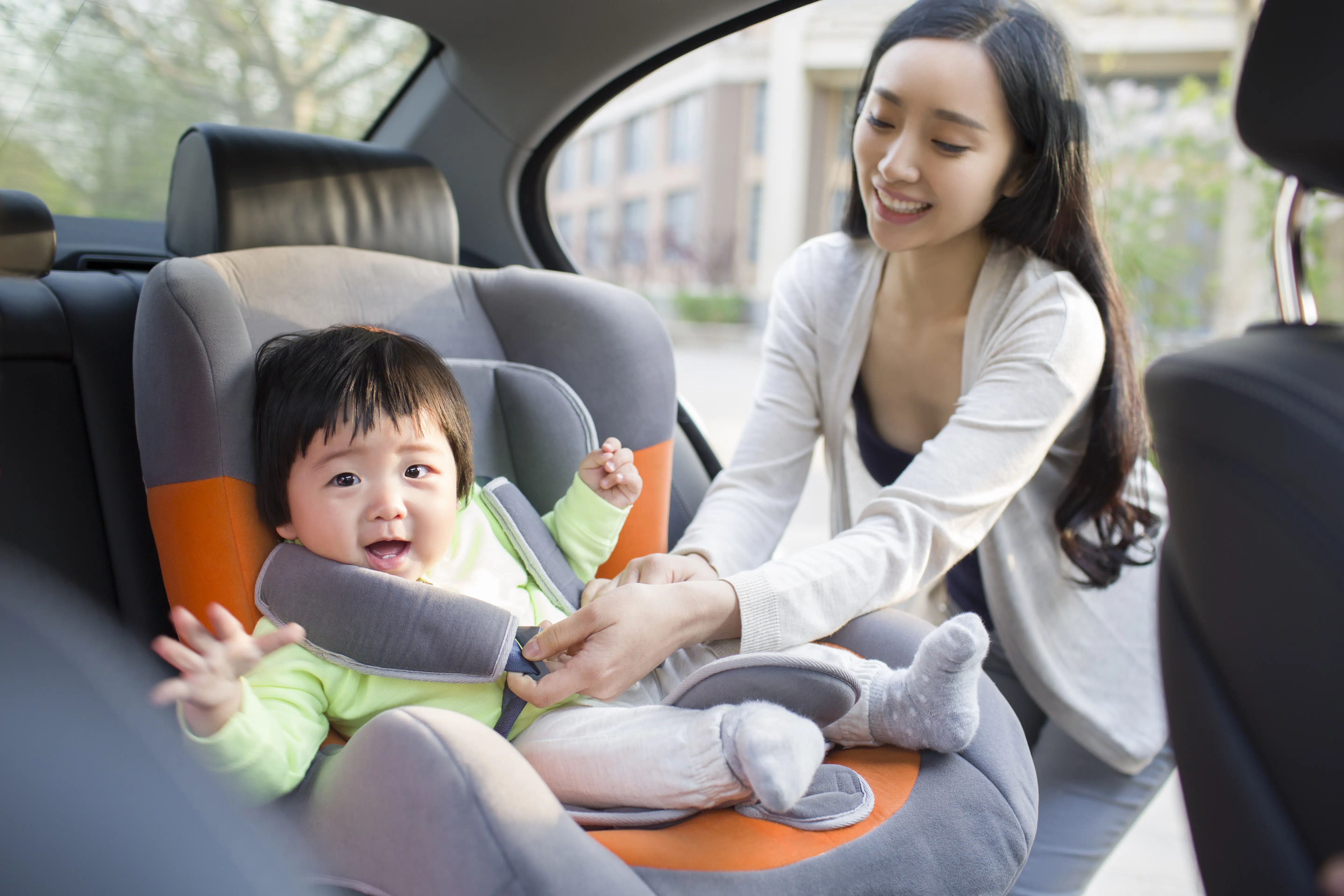Home » Blog » Car » Car Health & Safety » 5 Baby Car Safety Measures You Should Know
Categories
Tags
animal welfare
breed profile
buying a car
buying a pet
Car
car accessories
car care
car features
car insurance
Car safety
car sales
car service
cat
cat behaviour
cat body language
Cat Breeds
cat food
cat insurance
comprehensive car insurance
Dog
Dog Behaviour
dog body language
Dog Breeds
dog food
Dog Insurance
dog training
eco friendly cars
Kitten
New Car
pet accessories
pet activities
Pet Adoption
pet breeders
pet days of the year
pet fun stuff
Pet Health
pet insurance
pet parenting
Pet Safety
pet services
Puppy
rescue pets
road safety
road trip
safe driving
Recent Blog:
Facebook Posts
1 day ago
Growing old sometimes means we can’t take care of pets anymore. Find out some advice on what to do when this happens:![]()
![]() Senior Pet Parents – Contingency Plans for Your Pet – bit.ly/44bzwkS
... See MoreSee Less
Senior Pet Parents – Contingency Plans for Your Pet – bit.ly/44bzwkS
... See MoreSee Less
Senior Pet Parents' Contingency Plans for Pets
www.pd.com.au
Sometimes senior pet parents need more downtime. For older pet owners, this can be tricky to navigate if their dog or cat is full of beans and wants to3 days ago
Before you rev up the engine, let’s run through a checklist of things to do before starting your car. Not only do these steps ensure your safety (and that of others around you), but they also help in maintaining your vehicle's longevity.![]()
![]() Driving Tips: Your Checklist Before Starting Your Car -
... See MoreSee Less
Driving Tips: Your Checklist Before Starting Your Car -
... See MoreSee Less
Driving Tips: Your Checklist Before Starting Your Car
www.pd.com.au
Heading out for a drive? Hold up a second! Whether you're dashing off to work, running errands, or embarking on a road trip adventure, there are a few1 week ago
Are intestinal worms setting up camp in your dog’s gut without paying rent? Here’s how to spot the main culprits and get rid of them too:![]()
![]() Preventing, Identifying and Treating Intestinal Worms in Dogs - bit.ly/43YjCKu
... See MoreSee Less
Preventing, Identifying and Treating Intestinal Worms in Dogs - bit.ly/43YjCKu
... See MoreSee Less
Preventing, Identifying and Treating Intestinal Worms in Dogs
www.pd.com.au
Intestinal worms, such as roundworms in dogs are one of the least glamorous topics on the planet. These intestinal parasites that basically use our dogsWhen it comes to baby safety in the car, the baby car seat is a must. Securing your precious bundle properly every time you drive is part and parcel of being a responsible parent. It can very well save their life in an accident.
Having said that, there are other car baby safety factors you should know too, so this article doesn’t just explore the finer details of using a car seat properly (and test your knowledge!). We also look at additional baby safety measures you should take when driving.
In this article
1. The baby car seat
We’ve written extensively about why car seats for kids are a must, but let’s revise the most important points especially as they relate to baby car seats:
- By Australian law (National Child Restraint Guidelines), babies must sit in a rear-facing car seat until they’re at least six months old.
- After six months, babies can switch to a forward-facing car seat with a harness and should use this until they outgrow the height and weight limits set by the manufacturer.
- When children outgrow the forward-facing car seat, they should use a booster seat until at least seven years old. A booster seat helps position the seatbelt correctly.
- Children who are tall enough (145 cm) or reach 12 years of age (whichever comes first) can use the regular seatbelt without a booster seat.
- Rear facing seats offer the most amount of protection because their position cradles the head during a crash. It’s for that reason that you should keep your baby in a rear-facing seat for as long as possible. Just look at the difference between the safety provided by a rear vs a forward facing car seat in this video:
- The baby car seat needs to be secured using an ISOFIX base or seatbelt. When you push and pull on it, it should move no more than 2.5cm in any direction. Read more on car seat installation safety.
- Make sure the arm straps fit snugly around the baby’s shoulders and chest, but don’t go over their neck or face. You can check that they’re the right fit using the “pinch test“. If you’re able to pinch any amount of fabric on the shoulder straps, it’s too loose. Also ensure there are no twists in the straps as this can increase injury during a crash.
A common baby car seat mistake
Before we go on to our other car baby safety tips, did you know this common car seat mistake? Especially in winter, parents may bundle their babies or kids up in thick jackets or onesies, and then secure the straps over that.
The extra room given by the jacket means the car seat’s straps aren’t as close to the child as they should be. The video below will show you why that’s a problem. Rather, take the snuggie or jacket off and lay a blanket on top of the child after you’ve secured them.
Test your baby car seat knowledge
Do you feel like a car seat pro yet? For a quick test, look at the below images and tell us what baby safety mistakes are being made here. You can check the answers at the bottom of this piece.
a.
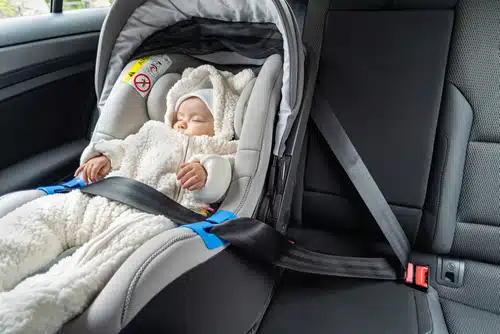
b.
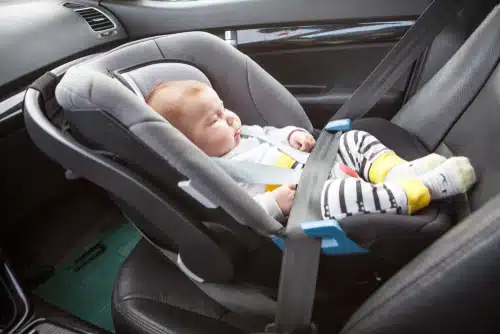
c.

How did you do? If you feel like you need more info, bookmark our article on child car seat safety every parent should know then keep reading this one.
2. Backseat visibility
It’s important to be able to see your baby while they’re in the backseat. Not only can you spot an emergency like choking, but it offers peace of mind and less distracted driving. Placing their car seat behind the front passenger seat offers the most visibility, especially when they’re forward facing. It’s also the safest position in the car.
In order to see them when they’re rear facing, hang a baby car mirror on the back seat headrest. Position it so you can see their reflection in your rearview mirror. Read this quick guide on what to look for in a baby car mirror.
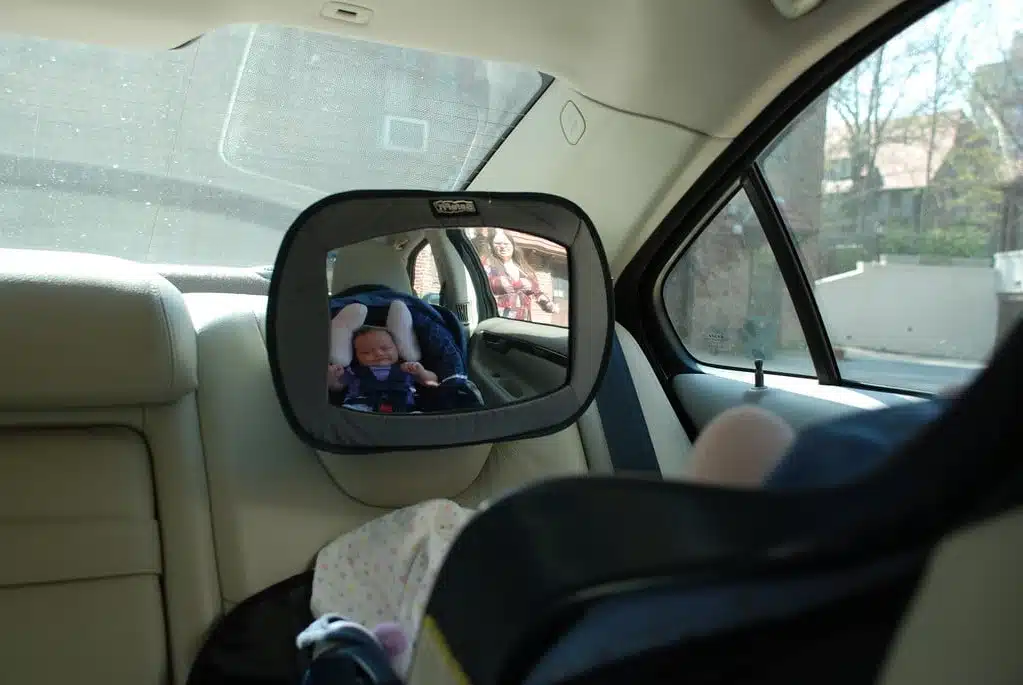
3. Remove loose or sharp objects
Always ensure there aren’t loose items lying around in your car. This includes toys, rattles, bottles and even pets. The velocity created by a crash turns these objects into projectiles that can further injure your baby, and you. Sharp objects are doubly dangerous and your baby can hurt themselves if they get a hold of it.
4. Be aware of overheating
Babies can overheat quite easily, so make sure they’re appropriately dressed for the weather. You may even want to consider window tinting or window coverings. Never ever leave you baby alone in the car, no matter if the weather feels cool or how long you’ll be away.
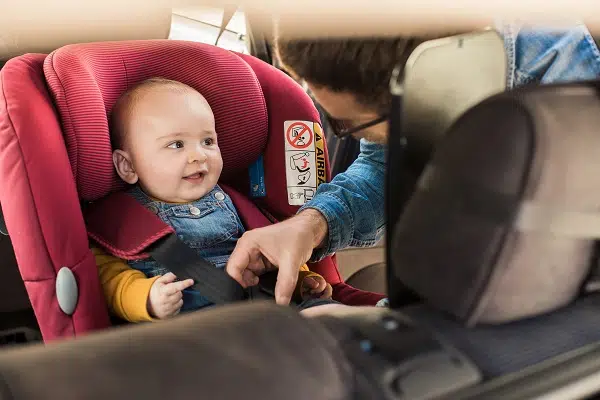
5. Make sure YOU’RE in good shape
We’ve spoken about the importance of using a baby car seat properly. But one of the biggest safety measures you can take is ensuring you’re fit to drive – every time.
What does that mean? It’s about doing a quick mental and physical self-assessment before you get into the car and being honest about whether you’re okay to get behind the wheel.
Being fatigued (which new parents are, often!) can have a huge impact on your response speed and alertness. Being overly stressed, emotional, or distracted when driving reduces your ability to focus on the road. If you think you’re too tired to drive with your baby, postpone your trip. Or, perhaps you could phone a friend or family member to drive you instead.
Check out our safe driving tips to protect you and your family for more.
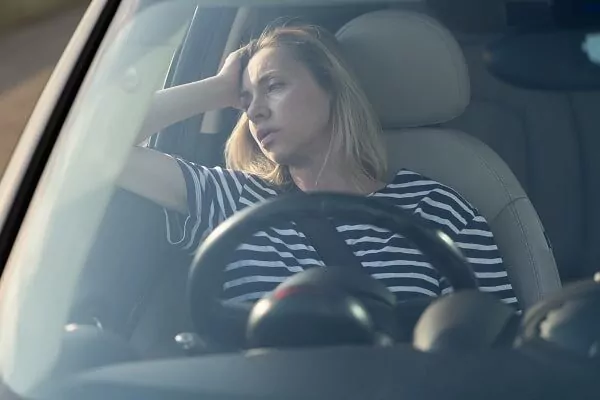
Buckle your baby car seat and get insured!
At PD Insurance we want you to stay happy and safe. That’s why we believe it’s important to make sure you’ve got your bases covered with affordable and comprehensive car insurance. Keep yourself financially protected with our value-rich, award-winning cover so you can focus on what really matters – enjoying every minute with your baby!
*******************************************
Baby car seat quiz answers
A: This baby is too young to be in a forward facing car seat. The baby is also wearing a puffy onesie, which causes a gap between the car seat straps and their body. The onesie should rather be removed for baby safety and, if needed, a blanket placed on top of the baby after they’ve been strapped in.
B: This baby and car seat have been placed on the front passenger seat, which is very dangerous. Babies and children should always be strapped in at the back of the car.
C. The car seat’s straps are twisted and the baby is wearing a puffy jacket.
Share On:

